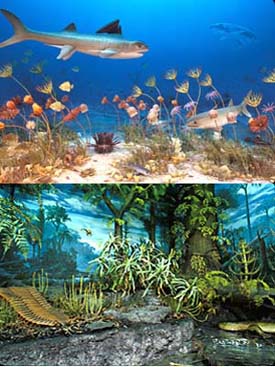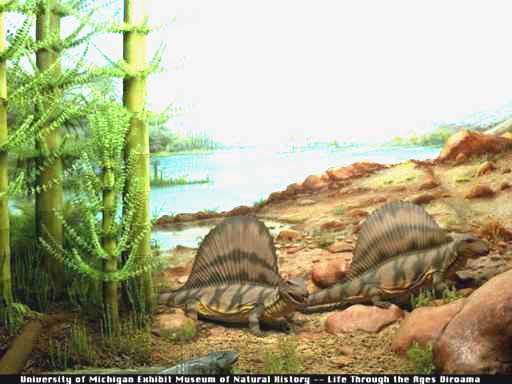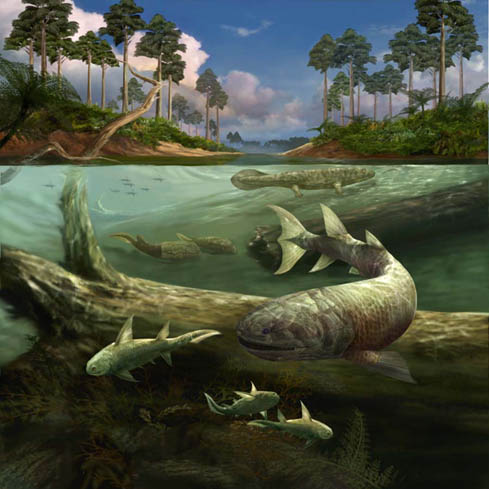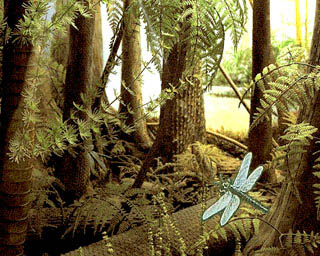As and after we walk through the geologic time scale, use the post below to fill out your cards about the different time segments.
Task 1: Time Scale Walk Prep
1) Look at your assigned card. As you read the information below, determine which time period your event or species is from.
2) Note this on your time scale card for that period along with one interesting fact.
3) During our Time Scale walk, you will present this to the class.
Task 2: Questions
1) The atmosphere formed during the _____________. What created the atmosphere?
2) Track NC's geologic history on different cards.
3) Pangea formed during the ______________ period.
4) During which period was the last ice age?
Precambrian Era (4500 mya to 540 mya)
During the Precambrian Era, the Earth and atmosphere form.

 Life is unicellular prokaryotes (one-celled organisms with no nucleus). Photosynthesis begins and this helps create the atmosphere.
Life is unicellular prokaryotes (one-celled organisms with no nucleus). Photosynthesis begins and this helps create the atmosphere.Volcanic explosions of water and carbon dioxide help create the atmosphere and oceans. Banded iron formations appear because oxygen levels in the atmosphere and sea rise.
Early life explodes. Life during the Cambrian Era included sponges, segmented worms, trilobites, and brachiopods.
The land that became North Carolina was near the equator. It was an island arc.
 Early plants grew on Earth. There were trilobites, jawless fish, bivalve mollusks, nautiluses, and gastropods. Ice caps grew in what is now Northern Africa.
Early plants grew on Earth. There were trilobites, jawless fish, bivalve mollusks, nautiluses, and gastropods. Ice caps grew in what is now Northern Africa. Life during the Silurian included crinoids, trilobites, brachiopods, gastropods, coral reefs, fish with jaws, and nautiluses. Extensive erosion occurred.
Life during the Silurian included crinoids, trilobites, brachiopods, gastropods, coral reefs, fish with jaws, and nautiluses. Extensive erosion occurred. The Devonian was the age of fishes. Life includes ammonites, starfish, corals, crinoids, armored fish, sharks, early bony fish, and amphibians.
The Devonian was the age of fishes. Life includes ammonites, starfish, corals, crinoids, armored fish, sharks, early bony fish, and amphibians.The Appalachians began to form.


Mississippian Period (354 mya to 323 mya)
Life includes snails, amphibians, sharks, and freshwater clams. Trilobite populations drastically decrease. Armored fish became extinct. There are tree ferns. The first plants with seeds appear.
Much of North America was underwater.
Spiders, cockroaches, flying insects, early reptiles, and amphibians lived during the Permian. Cycads were one of the main plants.
Reptiles develop from amphibians.
There are huge swamps. These became today's coal deposits.
Permian Period (290 mya to 248 mya)
 Reptiles have moved onto land. Beetles, bugs, and ammonites are some of the main living organisms. Conifers (pine trees) grow on land.
Reptiles have moved onto land. Beetles, bugs, and ammonites are some of the main living organisms. Conifers (pine trees) grow on land.At the end of the Permian Period there is a mass extinction and the fossil record changes dramatically.
Pangea forms and the Appalachians grow.
Triassic Period (248 mya to 206 mya)
Arthropods (early mites and beetles) and reptiles live on land. Therapsids, the first mammal-like reptiles, appear. Bony fish, turtles, other marine reptiles, and sea urchins live in the oceans. Early dinosaurs roam the seas and lands.
Pangea breaks apart. The Rockies and Sierra Nevadas form.
Jurassic Period (206 mya to 144 mya)
 Flying reptiles soar through the sky. Forests become more diverse, with cycads, yew trees, redwoods, conifers, and cypresses. There are dinosaurs!
Flying reptiles soar through the sky. Forests become more diverse, with cycads, yew trees, redwoods, conifers, and cypresses. There are dinosaurs!The Rockies continue growing and North America separates from Africa.
Cretaceous Period (144 mya to 65 mya)

 Dinosaurs dominate the animal kingdom. Flying reptiles still soar through the sky. Reptiles swim the seas. There are also amphibians, lizards, early crocodiles, and birds. Early mammals develop. Snakes and the first primates appear.
Dinosaurs dominate the animal kingdom. Flying reptiles still soar through the sky. Reptiles swim the seas. There are also amphibians, lizards, early crocodiles, and birds. Early mammals develop. Snakes and the first primates appear.A mass extinction due to an asteroid impact at the end of the Cretaceous paves the way for mammals to take over the animal kingdom. Currently, geologists think the Gulf of Mexico is where the asteroid hit the Earth. There is a lot of evidence to support that location as the location of asteroid impact.
Tertiary Period (65 mya to 2 mya)
 |
| Early homonids |
 Modern life becomes more and more diverse. Whales, dolphins, and manatees swim the seas. Amphibians, lizards, crocodiles, and snakes thrive. Early deer, antelope, and pronghorns roam the land. Cats, pigs, and weasels develop. The Tertiary Period ended with the beginning of the most recent ice age. Camels lived in South Carolina. Homonids develop.
Modern life becomes more and more diverse. Whales, dolphins, and manatees swim the seas. Amphibians, lizards, crocodiles, and snakes thrive. Early deer, antelope, and pronghorns roam the land. Cats, pigs, and weasels develop. The Tertiary Period ended with the beginning of the most recent ice age. Camels lived in South Carolina. Homonids develop.Earthquakes are common. Sea levels rise, the Appalachians uplift and erosion increases. There is a lot of volcanic activity in North America and Africa. The Grand Canyon forms.
Quaternary Period (2 mya to today)

 Giant ground sloths and beavers, mastodons, bison, saber-tooth cats, and mammoths thrive before the last ice age ended 10,000 years ago. Human beings evolve. Asian humans migrate and settle in the Americas. Extinction is common.
Giant ground sloths and beavers, mastodons, bison, saber-tooth cats, and mammoths thrive before the last ice age ended 10,000 years ago. Human beings evolve. Asian humans migrate and settle in the Americas. Extinction is common.After the end of the last ice age, large mammals died out and species of today became dominant.
Ice sheets form during the last ice age. After the end of the last ice age, beaches and barrier islands form in the southeast of the US.
 One method that scientists use to study the climate changes of the Quaternary Period is drilling and studying ice cores. In the world's polar regions, ice can be studied to learn about the climate as far back as 750,000 years ago. Every year, snowfall is compacted and becomes ice. Ice holds gases in it, specifically, CO2. Ice also contains...WATER. Water is made up of hydrogen and oxygen. There are different variations of hydrogen and oxygen (or any element) called isotopes. Scientists can look at the different ratios of isotopes of hydrogen and oxygen to figure out the temperatures during different parts of geologic past.
One method that scientists use to study the climate changes of the Quaternary Period is drilling and studying ice cores. In the world's polar regions, ice can be studied to learn about the climate as far back as 750,000 years ago. Every year, snowfall is compacted and becomes ice. Ice holds gases in it, specifically, CO2. Ice also contains...WATER. Water is made up of hydrogen and oxygen. There are different variations of hydrogen and oxygen (or any element) called isotopes. Scientists can look at the different ratios of isotopes of hydrogen and oxygen to figure out the temperatures during different parts of geologic past. From these ice cores, we can tell that the last continental glaciation (when continents were covered by glaciers) in North America was from 70,000 to 10,000 years ago. An interesting fact is that much of North Carolina and the Southern Appalachian mountain region was not covered in glaciers during that time period.
From these ice cores, we can tell that the last continental glaciation (when continents were covered by glaciers) in North America was from 70,000 to 10,000 years ago. An interesting fact is that much of North Carolina and the Southern Appalachian mountain region was not covered in glaciers during that time period.Task 3: Geologic Time Scale Walk
During the Geologic Time Scale Walk, present your information when we get to your time period/s. Take notes on what other people present.
1)) The period I would most want to visit is __________________ because _____________________.
3) WHAT DO YOU THINK QUESTION: The Southern Appalachian region was not covered by glaciers in the last ice age. How do you think this would impact life in the region?
Have fun exploring the past!
Ms. Nickel
Sources:
http://imnh.isu.edu/exhibits/online/geo_time/geo_time_periods.htm
http://www.bgs.ac.uk/climatethroughtime/
ftp://ftpdata.dnr.sc.gov/geology/Education/PDF/Geologic%20Time.pdf
http://dnr.wi.gov/org/caer/ce/eek/teacher/Climateguide/pdf/01-1823-icecores.pdf
http://dnr.wi.gov/org/caer/ce/eek/teacher/Climateguide/pdf/01-1823-icecores.pdf













No comments:
Post a Comment